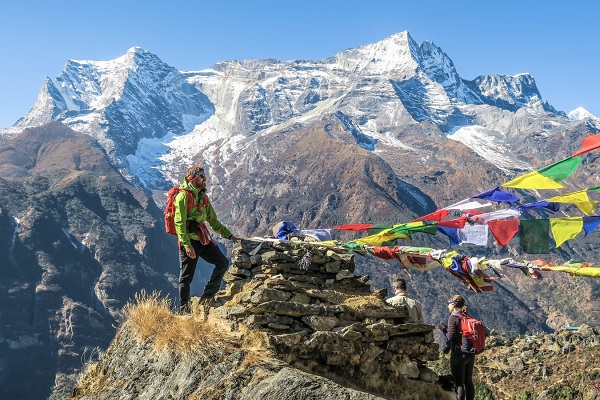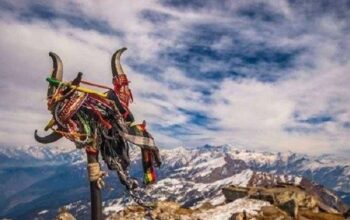Everest Base Camp, which is in northeastern Nepal, is one of the most picturesque works of art on Earth. It is surrounded by the formidable Mount Everest and other peaks, deep ravines, and Himalayan glaciers. This national park, which is located 135 kilometers from Kathmandu, is one of the Sacred Himalayan Landscapes and is recognized by UNESCO as a World Heritage Site. Every facet of nature’s beauty is conserved here, from the flora and fauna to the breathtaking terrain.
This brief overview of Sagarmatha National Park will help you make the most of your trip there if you are considering it.
Best time to go trekking
October through November and March through May are the ideal months to travel. Avoid going there from June to September as it gets a lot of rain there—about 1000 mm—which makes hiking and camping challenging. December through February are the coldest months of the year, and snowfall is frequent during these times.
Location of the trek
Sagarmatha National Park was created in 1976 and is situated in Nepal’s Khumbu area. It is Nepal’s first national park. This bio reserve covers an area of 1148 square kilometers and has an altitude range of 2845 to 8848 meters. The Qomolangma National Nature Preserve of Tibet Autonomous Region and the Dudh Koshi River are both about Sagarmatha National Park. In 1979, Sagarmatha National Park was designated as a natural World Heritage Site.
How to reach there?
By air
The Tenzing-Hillary Airport in the Lukla area is the closest airport to Sagarmatha National Park. The only international airport in Nepal is located in Kathmandu, which is where visitors arriving from abroad must first arrive. There are frequent flights from the domestic terminal of Tribhuvan International Airport.
It is in the capital to the terminal in Lukla; the flight takes around 25 minutes in total. A two-day walk can be used to traverse the remaining distance from Lukla to Sagarmatha.
You can also choose to fly from Kathmandu to Phaplu or Tumlingtar and then hike the remaining distance to Sagarmatha after five or 10 days, respectively. For individuals who are not comfortable trekking, direct helicopter flights from Kathmandu to Sagarmatha are available at places like the Everest Base Camp, Kala Patthar, and Namche Bazaar inside the National Park.
By road
Sagarmatha National Park cannot be reached by road directly. The most convenient method is to take a bus from Kathmandu to Jiri, a settlement that is roughly 100 kilometers from the park. A 10-day walk from Jiri will get you to Sagarmatha.
The alternative route from the airport to Lukla to reach Sagarmatha is to take a bus to the nearby village of Salleri, which is also close to the settlement of Phaplu. The remaining distance to the park is hiked over five days from Salleri.
Entry fees and timings of the Sagarmatha national park
It is advised to visit the picturesque park before nightfall even though it is accessible to all tourists around-the-clock. Because there is endemic fauna there, hiking and trekking at night might be dangerous.
To enter, you must purchase an entry pass from the Sagarmatha National Park tourist center, which is situated at Monzo and Namche Bazaar. The cost of the pass is INR 1500 for SAARC citizens, INR 3000 for foreigners, and INR 25 for Nepalese citizens. To issue the access pass, passports are necessary.
Flora of the region
The national park’s elevation ranges from 2845 to 8848 meters, which results in a noticeable difference in vegetation types. Rhododendrons, birch, juniper, blue pines, fir, and bamboo are the dominant species in lower elevation forests. Dwarf bushes, mosses, and lichens can be found at higher elevations. In April and May, rhododendrons blossom, and they continue to be brilliant and vibrant into September.
Fauna of the region
The park is home to a variety of animals, including the Himalayan Tahr, Musk deer, Ghoral, snow leopards, wolves, lynx, and weasels. Nearly 1000 rare to endangered bird species may be found in Sagarmatha National Park, including the Himalayan monal, Snowcock, Yellow-billed chough, Blood pheasant, and Red-billed Chough. This is the reason BirdLife International designated Sagarmatha National Park as an Important Bird Area.
Places to stay near Sagarmatha national park
Looking for a place to stay while visiting this park? The best lodging in or close to the park is some sort of regular demand. Since there aren’t any hotels or resorts with all the amenities close to the park, every traveler worries about where to stay near Sagarmatha National Park. But don’t worry! There are numerous respectable lodges and homestays in the area that provide convenient lodging with the essentials. You can make reservations at the Hotel Khangri, Thanka Inn, Everest Inn, and Yeti Mountain Home Phakding







